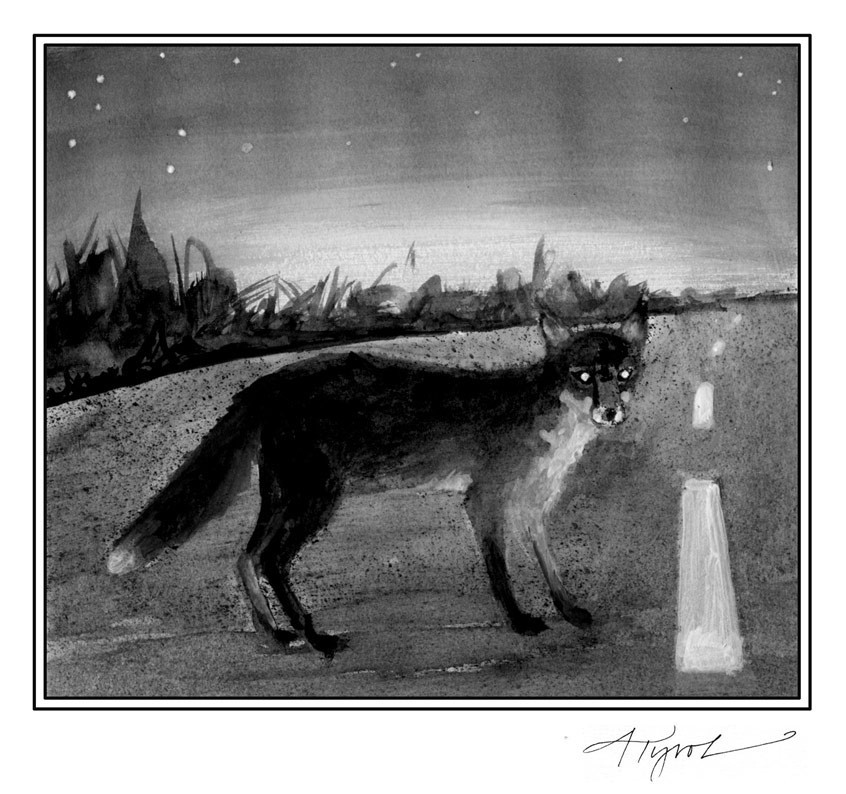
Route 113 at twilight. The sun’s last gasp now just a smear in the western sky. Early stars over a stripe of asphalt that’s meandering down into Chelsea. My truck upon that road. The sound of tires braking, the engine winding down, the faint hiss of pad on rotor.
The red fox puppy, in the middle of the road, stared back at the truck, unsure of how to proceed. He’d been dragging a piece of carcass across the road – a section of rib cage as big as himself – but my sudden appearance had foiled his plans. As my truck crested the hill, he spooked, sort of. First he bolted into the bushes, then he changed his mind and darted back out into the road, latched onto the gore, and tried to pull it a bit more. But it was too heavy, and with my truck nearly upon him, he lost his nerve again and headed back into the woods.
There are two types of fox in Vermont and New Hampshire, the red (Vulpes vulpes), and the gray (Urocyon cinereoargenteus). Reds appear longer and taller, and grays, with their shorter legs, a bit more catlike. Every once in a while you’ll see a red fox with black fur, which is a natural, though rare, color variation. Sometimes you’ll see a red fox that’s half red and half black. People call the black ones “silver foxes” and the mottled ones “cross foxes,” but both are Vulpes vulpes.
As a general rule, reds prefer open farmland and grays are more at home in wooded settings, though the home ranges of both species overlap. In Mark Elbroch and Kurt Rinehart’s excellent book, Behavior of North American Mammals, the authors suggest that reds and grays that share the same home range appear to use time-share strategies to avoid interactions. Reds are famously intolerant of each other, and territorial interactions have been characterized by animal behaviorists as barroom brawls.
Both reds and grays suffer from competition from coyotes, a new species that showed up in the northeast 60 or 70 years ago. Grays may have an easier time coexisting with coyotes, as they can climb trees to escape bullying (they’re the only member of the dog family known to climb), but in one western radio collar study, coyotes still killed one-third of the collared gray foxes. Interestingly, in areas with wolf populations, foxes and wolves seem to coexist peacefully, while wolves treat coyotes like coyotes treat foxes. It’s like junior high, but with sharp teeth. In any case, if you have a fox den under your barn, or your porch, conventional wisdom among naturalists holds that they’re probably there to escape coyote predation. From the fox’s perspective, you’re the lesser of two evils.
Both breeds of foxes are vocal and make a variety of sounds. Most common is a single syllable alarm bark that’s repeated regularly and monotonously. If you hear something that sounds like a cross between a dog and a crow, it’s probably a red fox.
Both fox species are omnivorous and make the most of whatever food source is around: mice, bugs, grass, nuts, you name it. In a few weeks, look for fox scat that’s bright red and full of strawberry seeds.
Mating season for reds begins in February, for grays it starts a bit later. Puppies are born in 50 to 53 days. Parents co-raise the young, and often keep several den sites both for protection and to escape fleas. The female nurses the pups and both parents bring food back to the den. Adults regurgitate food for their young, an act that’s prompted by the puppy licking the nose and sides of the adult’s mouth.
By the fifth or sixth week a hierarchy is established among puppies, and as summer unfolds, the pups explore farther afield. They’re crepuscular – a fancy word meaning especially active at twilight – so an evening or early morning walk through a meadow is a great time for a fox sighting.
Back on Route 113, I drove around the carcass, pulled forward about 50 feet, then pulled to the road’s shoulder and turned off my truck. The idea was to pull the free meal out of the road so the fox wouldn’t get hit. But I never got out. In the rear-view mirror, two different puppies materialized, latched onto the carcass, and pulled it, together, back the way they had come.


Discussion *